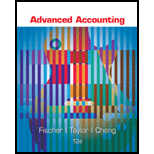
Concept Introduction:
Consolidation of Statements:
In today’s world of business acquisition of smaller companies is common and such acquisitions helps in the growth of the parent company. Once a company acquires another company the net assets of the other company is recorded in the books of the parent company. Consolidation of financial statements of both the parent company and subsidiary company is important for the stockholders of the parent company. A parent company may choose any of the two basic methods for consolidation and they are the equity method or cost method. The accounting methods used by a parent company for consolidation is purely based on their convenience.
To analyse: The components of non-controlling interest on consolidated
Want to see the full answer?
Check out a sample textbook solution
Chapter 3 Solutions
Advanced Accounting
- What is the manufacturing overhead applied to production?arrow_forwardThe computer workstation furniture manufacturing that Santana Rey started is progressing well. As of the end of June, Business Solutions's job cost sheets show the following total costs accumulated on three furniture jobs. Direct materials Direct labor Overhead applied Job 602 $ 1,700 Job 603 Job 604 900 540 $3,700 1,580 948 $ 3,000 1,500 900 Job 602 was started in May, and the following costs were assigned to it in May: direct materials, $600; direct labor, $150; and overhead, $90. Jobs 603 and 604 were started in June. Overhead cost is applied with a predetermined rate as a percent of direct labor costs. Jobs 602 and 603 are finished in June, and Job 604 is expected to be finished in July. The company's predetermined overhead rate did not change over these months. Required: 1. What is the cost of direct materials used in June for each of the three jobs and in total? 2. What is the cost of direct labor used in June for each of the three jobs and in total? 3. What predetermined…arrow_forwardOn January 1, 2015, a new business was started with an initial investment of $12,000 in cash and $8,500 in equipment. During the year, the owner withdrew $3,500. When preparing the Statement of Owner’s Equity, the final balance was recorded as $22,500. Based on this information, what was the net income or loss for the year? A. $5,500 net loss B. $3,500 net income C. $3,500 net loss D. $5,500 net incomearrow_forward
- I need correct answer of this general accounting questionarrow_forwardDirect labour cost variance: The standard material cost for vinyl use per table is $7.80 based on 6 square feet of vinyl at a cost of $1.60 per square foot. A production run of 1,000 in January resulted in usage of 6,400 square feet of vinyl at a cost of $1.20 per square foot, a total cost of $7,689. What is the quantity variance resulting from the above production run?arrow_forwardCan you please solve this financial accounting question?arrow_forward
- Grand Edge Ltd. manufactures high-performance gears requiring 9.2 standard hours per unit at a standard hourly rate of $14.80 per hour. The company produced 7,500 units, consuming 70,800 hours at an actual hourly rate of $14.50 per hour. Determine the direct labor (a) rate variance (b) time variance (c) cost variancearrow_forwardcompute the traditional overhead rate per labor hour.arrow_forwardAt the beginning of the year, a company predicts total direct materials costs of $920,000 and total overhead costs of $1,150,000. If the company uses direct materials costs as its activity base to allocate overhead, what is the predetermined overhead rate it should use during the year?arrow_forward
 Auditing: A Risk Based-Approach (MindTap Course L...AccountingISBN:9781337619455Author:Karla M Johnstone, Audrey A. Gramling, Larry E. RittenbergPublisher:Cengage Learning
Auditing: A Risk Based-Approach (MindTap Course L...AccountingISBN:9781337619455Author:Karla M Johnstone, Audrey A. Gramling, Larry E. RittenbergPublisher:Cengage Learning

